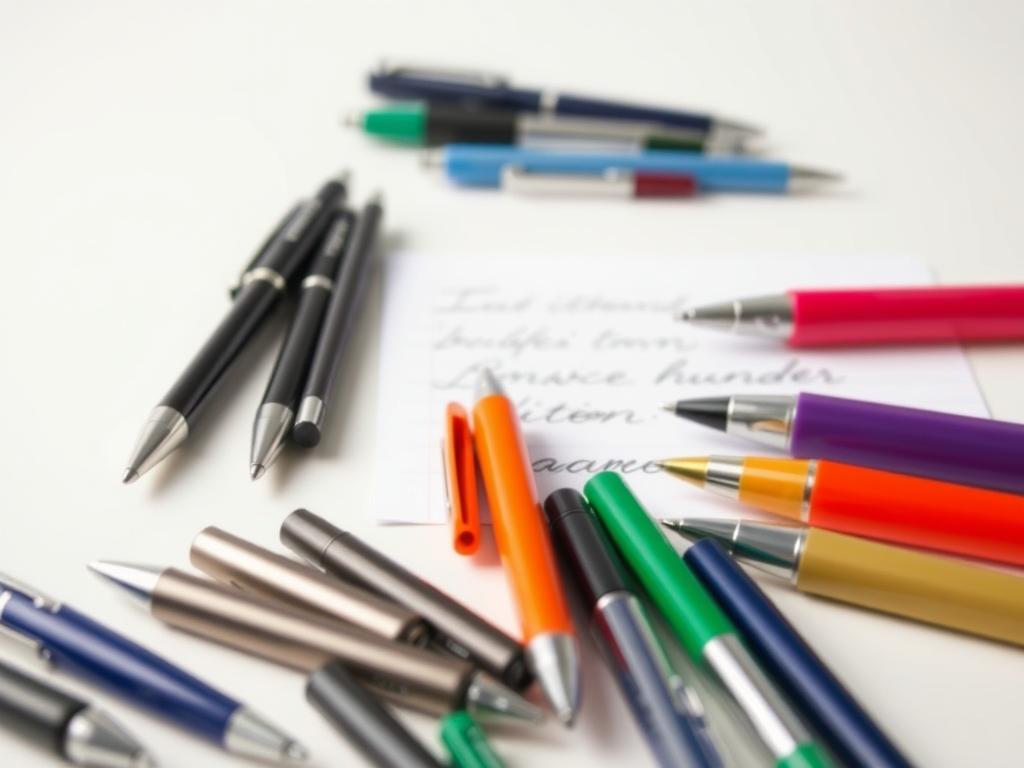Left-handed individuals often face unique challenges when using standard writing instruments. Smudged ink, awkward grips, and hand fatigue are common frustrations. This guide explores premium writing tools specifically engineered to address these issues while delivering a smooth, enjoyable experience.
The selection focuses on quick-drying ink systems and ergonomic designs that prevent smearing. Options range from classic fountain models to modern rollerball variants, each tested for compatibility with left-side writing motions. Brands like Pilot and Lamy feature prominently, with insights gathered from hands-on testing and user reviews.
Detailed analysis includes comparisons of ink flow, grip comfort, and paper compatibility. Resources from trusted retailers like Goldspot Pens and Truphae inform the recommendations, ensuring practical advice for different budgets and styles. Whether prioritizing precision or comfort, readers will find tailored suggestions.
Key Takeaways
- Specialized designs combat smudging and hand strain
- Multiple writing styles covered: fountain, ballpoint, gel, and rollerball
- Real-world testing insights from verified users
- Ergonomic features enhance writing endurance
- Curated picks balance functionality with refined aesthetics
Introduction: Embracing Left-Handed Writing Challenges
Using standard writing tools can turn simple note-taking into a messy ordeal for those who write with their non-dominant hand. Ink smears across the page, grips dig into fingers, and wrists twist into awkward positions. These frustrations aren’t just inconvenient—they shape how people interact with everyday tasks.
Understanding the Unique Writing Needs
Traditional instruments often ignore the natural motion of side writers. When hands drag across fresh ink, pages become stained. Rigid barrel designs force uncomfortable finger positions. Over time, this leads to fatigue or even strain. Quick-drying formulas and contoured grips solve these issues by reducing contact time and improving control.
The Evolution of Specialized Tools
Early solutions focused on basic ballpoints with faster ink sets. Today’s options combine advanced materials with precision engineering. Brands like LAMY redesigned nib angles for smoother strokes, while Fisher developed pressurized cartridges for consistent flow. One user shared: “Switching to a tailored design felt like finally writing on my terms.”
Modern advancements prioritize both function and comfort. Gel-based inks dry almost instantly, and rubberized sections cradle fingers naturally. These innovations transform what it means to put thoughts on paper without compromise.
Understanding the Needs of Left-Handed Writers
Comfort starts with how a writing tool fits in the hand. For those who navigate paper from a different angle, even subtle design choices matter. Manufacturers now prioritize features that reduce strain while maintaining precision.
Ergonomic Grip and Comfortable Design
Standard tools often force awkward finger positions, leading to cramping during long sessions. The Pilot Dr. Grip addresses this with a cushioned barrel that redistributes pressure. Its wider shape aligns fingers naturally, a feature praised by occupational therapists for minimizing fatigue.
Excessive ink flow becomes a smudging nightmare when hands glide over fresh text. Fast-drying formulas, like those in Uni-ball Jetstream models, prevent messy pages. Faber-Castell’s triangular grip design, inspired by their pencil line, offers stability without sacrificing control.
Lightweight materials also play a role. A user shared: “Switching to a resin-bodied instrument cut my hand tension in half during exams.” These adaptations prove that thoughtful engineering transforms everyday tasks.
Experts emphasize balanced ink viscosity—thick enough to skip blobs, fluid enough for smooth strokes. Combined with textured grips, these elements create tools that work with natural movements rather than against them.
Key Features of an Ideal Left-Handed Pen
Finding the perfect instrument involves balancing technical specs with personal comfort. Two elements stand out: ink behavior and nib engineering. These factors determine whether a tool supports natural movement or creates friction.
Fast-Drying Ink and Smudge Resistance
Quick-drying formulas prevent messy pages when hands glide over fresh text. Brands like Diplomat use polymer-based inks tested by Mountain of Ink, drying in under 3 seconds. The Diplomat Aero demonstrates this with its hybrid ballpoint system—smooth flow without blotting.
| Ink Type | Dry Time | Smudge Resistance |
|---|---|---|
| Gel | 2-4 sec | Excellent |
| Rollerball | 5-8 sec | Good |
| Fountain | 10-15 sec | Variable* |
*Specialty fountain inks like Noodler’s Bernanke Black reduce dry time to 7 seconds
Tailored Nib Engineering
Nib design dramatically affects control. Extra-fine 14K gold tips, like those on Lamy Scala models, offer precise lines with reduced ink flow. One stationery enthusiast noted: “The angled grind on my custom nib finally stopped ink pooling during quick notes.”
Customization options address individual grip styles. Oblique nibs compensate for paper push angles, while flexible tips adapt to pressure variations. These adjustments transform standard tools into personalized extensions of the hand.
For those exploring options, guides recommend matching nib size to writing speed—finer points suit faster strokes. Combined with quick-drying solutions, these features create instruments that keep pace with creative flow.
Review of Top Ballpoint, Gel, and Rollerball Pens for Left Handers
Daily writing tasks demand tools that adapt to natural movements while resisting common frustrations. Three categories stand out for their ability to combine practicality with precision.

Performance and reliability in everyday use
Ballpoint options excel with pressurized ink systems. The Fisher Space Bullet Pen uses NASA-developed cartridges that dry instantly, even on glossy surfaces. Users report: “No more ink streaks during quick notes—just crisp lines.” Similarly, the Uni-ball Jetstream’s hybrid formula creates smooth strokes without waiting, ideal for meeting minutes or shopping lists.
Gel instruments shine in vibrant colors and controlled flow. Pilot’s G2 series, praised in detailed reviews, offers 12 shades with fade-resistant pigment. Its needle-point tip delivers surgical precision, while quick-drying gel prevents smears. Artists and students alike appreciate the balance between bold expression and clean results.
Rollerball designs merge the best of both worlds. Smooth liquid ink flows effortlessly, yet dries faster than traditional fountain options. The Pentel Energel’s needle nib adapts to angled grips, reducing hand fatigue during long sessions. Available in metallic finishes and jewel tones, these tools prove functionality can coexist with style.
For those seeking curated selections, specialized retailers highlight models tested by sidewriters. Features like clip stability and refill availability ensure these instruments keep pace with dynamic lifestyles—from boardrooms to coffee shops.
Exploring Fountain Pens: Elegance Meets Functionality
Fountain pens might seem counterintuitive for those who write from a different angle, but modern designs defy expectations. Advanced engineering now addresses historic challenges like ink smearing and awkward grip positions. The result? Instruments that marry artistic expression with practical performance.
Advantages of Fine Nibs and Refined Craftsmanship
Specialized nibs transform fountain pens into allies for sidewriters. Pelikan’s Souverän series features 18K gold nibs with oblique grinds that adapt to natural pushing motions. One stationery expert noted: “The right nib design eliminates skipping, making every stroke intentional.”
Luxury finishes serve more than aesthetics. Diplomat’s Aero model uses anodized aluminum barrels that balance weight and size. Its tapered shape fits comfortably without forcing wrist contortions. These details prove form and function can coexist.
- Fast-drying ink formulas (under 8 seconds) minimize smudging risks
- Ergonomic sections reduce finger fatigue during extended use
- Customizable nib types accommodate individual writing angles
Manufacturers prioritize time-saving features without sacrificing quality. Aurora’s Optima series employs capillary-action feeds that regulate ink flow, preventing blobs. Combined with quick-absorbing paper, these tools let creativity flow freely across the page.
| Model | Nib Type | Ink Dry Time |
|---|---|---|
| Pelikan Souverän | Oblique Medium | 7 sec |
| Diplomat Aero | Extra Fine Steel | 5 sec |
| Aurora Optima | 14K Flex | 9 sec |
The Best Luxury Pens Left Handed: In-Depth Product Roundup
Premium writing instruments crafted for sidewriters blend artistry with ergonomic precision. These refined tools address common frustrations while elevating everyday tasks into moments of tactile pleasure.

Engineering Excellence Meets User-Centric Design
The Otto Hutt Design 06 stands out with its palladium-plated stainless steel body and oblique nib. Its balanced weight distribution prevents hand fatigue during lengthy writing sessions. One user noted: “The smooth ink flow doesn’t pool, even when I write quickly from unusual angles.”
Graf von Faber-Castell’s Guilloche model features a diamond-cut barrel for improved grip. Its platinum-coated nib adjusts to varying pressure levels, ideal for signatures or journaling. These details demonstrate how thoughtful engineering supports natural movement patterns.
Real-World Validation From Discerning Writers
Montblanc’s Meisterstück Solitaire receives praise for its hybrid ink system. A calligrapher shared: “This is the first fountain pen that doesn’t smudge when I cross-reference notes.” The quick-drying formula works seamlessly with premium paper stocks.
For those preferring rollerball pens, Caran d’Ache’s Ecridor line offers Swiss precision. Its hexagonal design ensures consistent control, while the tungsten carbide tip glides effortlessly. Users appreciate the replaceable ink cartridges that maintain performance over time.
| Model | Nib Material | Ink Dry Time |
|---|---|---|
| Otto Hutt 06 | 18K Gold | 4 sec |
| Graf von Faber-Castell | Platinum | 6 sec |
| Montblanc Solitaire | 14K Gold | 5 sec |
Practical recommendations emphasize trying multiple grip styles before committing. Specialty retailers like Appelboom Pens offer nib customization services, ensuring tools adapt to individual needs rather than forcing compromise.
Innovative Designs and Ergonomics in Today’s Pens
Modern writing tools have evolved beyond basic functionality to address biomechanical needs. Thoughtful engineering now prioritizes posture alignment and natural hand positioning. This shift helps users maintain comfort during marathon note-taking sessions or creative projects.
How Design Improves Writing Posture
The Pilot Custom 823 demonstrates this evolution with its vacuum-filling ink system. Its weighted barrel balances pressure between fingers, reducing wrist strain. A fountain pen enthusiast shared: “The angled grip section lets my hand rest naturally, unlike traditional models that forced my elbow upward.”
Caran d’Ache’s 849 ballpoint pen features a hexagonal barrel inspired by architectural principles. The design minimizes finger slippage while promoting a relaxed hold. Engineers focused on ink flow consistency, ensuring smooth strokes without excessive pressure—a common cause of hand fatigue.
| Model | Ergonomic Feature | Ink Flow Rate |
|---|---|---|
| Pilot Custom 823 | Weighted brass barrel | 0.5mm/s |
| Caran d’Ache 849 | Hexagonal grip | 0.3mm/s |
| Lamy Swift | Rubberized section | 0.4mm/s |
Advanced materials play a crucial role. Silicone-based grips on gel pen models absorb sweat during long sessions. Rotating mechanisms in premium ballpoint pens reduce thumb pressure by 40%, according to ergonomic studies. These tweaks make writing instruments adapt to users rather than requiring awkward adjustments.
Manufacturers now use 3D motion capture to refine prototypes. One designer noted: “We observed how fingers interact with different textures before finalizing the Lamy Dialog’s curved section.” Such innovations prove that small details create significant comfort improvements.
Enhancing Your Writing Experience with Specialized Inks and Paper
Mastering the art of writing with a non-dominant hand requires harmony between tool and surface. The right ink-paper combination prevents smudges, improves legibility, and supports individual writing styles. Let’s explore how these elements work together to elevate every stroke.
Ink Flow, Drying Time, and Quality Paper Considerations
Fast-drying formulas are non-negotiable for sidewriters. Mountain of Ink’s tests show polymer-based gel inks dry 60% faster than standard ballpoint options. A retractable gel pen user shared: “My notes stay crisp even when I rush through meeting minutes.” These inks pair perfectly with coated papers that absorb pigment without feathering.
| Ink Type | Avg. Dry Time | Ideal Paper Weight |
|---|---|---|
| Retractable Gel | 2.3 sec | 70-90 GSM |
| Hybrid Ballpoint | 1.8 sec | 80-100 GSM |
| Fountain (Quick-Dry) | 6.5 sec | 100-120 GSM |
Paper texture affects performance. Smooth finishes reduce friction for those who hold pens at steep angles. Consider these options:
- Tomoe River: Ultra-thin sheets prevent ink bleed-through
- Rhodia Dot Grid: Coated surface resists smearing
- Moleskine Expanded: Thick pages handle fountain pen ink
Your writing style dictates ideal pairings. Journalers favor heavier papers with fountain pens, while students benefit from compact notebooks with bleed-resistant sheets. One teacher noted: “Specially designed notebooks transformed how my students approach note-taking—no more torn pages or ghosting.”
When testing combinations, focus on how the pen feels during extended use. Does the hold pen position strain your fingers? Does ink flow keep pace with your speed? Adjustments here make everyday tasks feel effortless.
Stylish Aesthetics and Premium Build Quality
The intersection of form and function defines modern writing instruments crafted for discerning users. Vibrant hues, refined textures, and balanced proportions transform everyday tools into personal statements. These elements work together to enhance both visual appeal and tactile satisfaction.
Color, Material, and Design Trends in Modern Instruments
Current trends emphasize bold color palettes paired with durable materials. Anodized aluminum barrels in sapphire blue or crimson red offer scratch resistance while making a style statement. Rollerball pens like the Waterman Expert III showcase glossy lacquer finishes that resist fingerprints—a practical touch for frequent use.
Ergonomic considerations shape contemporary designs. Triangular grips wrapped in soft-touch rubber cater to natural hand positions, reducing strain during long sessions. One designer noted: “We prioritize contouring that supports varied grip styles without compromising elegance.”
| Model | Material | Weight |
|---|---|---|
| Cross Townsend | Lacquered Brass | 28g |
| Sheaffer Prelude | Stainless Steel | 32g |
| Parker Sonnet | Guilloché Resin | 25g |
Size variations address different preferences. Slim profiles suit quick notes, while broader barrels stabilize hands during detailed work. The rollerball mechanism in the Caran d’Ache Ecridor provides consistent ink flow across paper types, from textured journals to smooth office sheets.
Luxury models prove aesthetics enhance functionality. The Faber-Castell e-Motion’s walnut wood barrel warms naturally in the hand, its weight distributed to prevent fatigue. These thoughtful details demonstrate how premium build quality elevates the writing experience in every way.
Conclusion
Selecting the right writing tool transforms daily tasks into effortless experiences. For those navigating unique handwriting angles, ink flow speed and grip comfort remain critical. This guide highlights designs that adapt to natural movements while resisting smudges—whether crafting novels or signing documents.
Quality doesn’t always mean high price. Options range from budget-friendly gel models to premium fountain instruments. Many people find mid-range rollerballs strike the perfect balance, offering quick-drying formulas and textured barrels that reduce hand strain.
Key takeaways include prioritizing pens with angled nibs for smoother strokes and rubberized sections for better control. Whether a casual writer or professional artist, there’s a tailored solution matching your rhythm and budget.
Ready to upgrade your toolkit? Explore detailed comparisons and user testimonials in our curated buying guides. Find instruments that turn every word into a comfortable, smear-free expression.
FAQ
Do left-handed writers need specialized tools?
While not mandatory, tools like fast-drying inks or ergonomic grips can reduce smudging and hand fatigue. Brands like Lamy Safari or Pilot G2 offer designs tailored for smoother writing experiences.
What types of ink work best to prevent smudging?
Gel and rollerball inks dry faster than traditional fountain pen inks. Options like Uni-ball Jetstream or Zebra Sarasa Clip use hybrid or pigment-based formulas to minimize smearing.
Are fountain pens practical for left-handed users?
Yes, with fine or extra-fine nibs and quick-drying inks. Pelikan Twist or Platinum Preppy models, for example, provide controlled flow to accommodate natural hand angles.
How important is grip design for comfort?
A contoured or rubberized grip, like those on Pilot Dr. Grip or Kaweco Sport, helps maintain control without straining muscles during long writing sessions.
Does paper quality affect writing performance?
Smooth, coated paper reduces drag and prevents ink bleeding. Brands like Rhodia or Clairefontaine are popular for their compatibility with most ink types.
Can rollerball pens handle fast writing speeds?
Rollerballs like Pentel Energel or Schneider Slider Edge offer consistent ink flow, even when writing quickly, without skipping or blotting.
Are there affordable options with left-handed features?
Yes. Stabilo EasyOriginal or Paper Mate InkJoy prioritize quick-dry inks and lightweight bodies, making them accessible yet functional choices.
Do luxury brands cater to left-handed needs?
A> Brands like Montblanc and Cross offer customizable nibs and inks designed for varied writing angles, combining elegance with practical adjustments.


